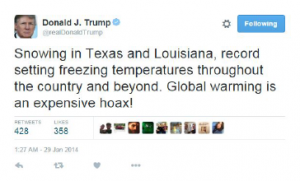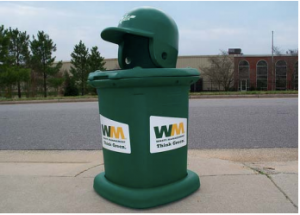Upon typing “Trump and the Environment” in google I was not surprised to see that the two do not have the most cordial relationship. Since Trump’s Inauguration in January of 2017, National Geographic has continued to keep an active list of the many changes to U.S. science and environmental policy. President Trump stepped into the White House and quickly undid many of the actions taken by Obama toward curbing climate change and limiting pollution as well as other environmentally harmful acts; Following this, President Trump thus announced that the United States will no longer regard climate change by name as a national security threat, viewing it as nothing more than a “burden”for businesses.
and environmental policy. President Trump stepped into the White House and quickly undid many of the actions taken by Obama toward curbing climate change and limiting pollution as well as other environmentally harmful acts; Following this, President Trump thus announced that the United States will no longer regard climate change by name as a national security threat, viewing it as nothing more than a “burden”for businesses.
With Trump’s new budget coined “ A New Foundation for American Greatness ,” he cuts the Environmental Protection Agency’s budget by 31 percent, a bigger cut than any other department; these cuts translate to a $2.7 billion spending reduction and the loss of 3,200 jobs. What the trump. A recent study done by EDGI finds that in the first year of the Trump administration, U.S. government websites have been

“systematically altered to cut mentions of climate change (Michael Greshko, National Geographic ). The words “climate change” are no longer directly mentioned and instead have been replaced with more vague words. Since Trump’s inauguration, the EDGI has been monitoring thousands of government web pages for changes or deletions; the EPA’s “Student’s Guide to Global Climate Change” went offline between February and April 2017 (Michael Greshko, National Geographic ). Okay Trump, just because you don’t want to talk about it, doesn’t make it go away.
If hiding the problem and eliminating protection wasn’t enough, now he wants to facilitate the problem. If you are not familiar with the Clean Power Act, it was a mandate issued in 2005 by the U.S. power sector to cut carbon emissions by 32 percent by 2030 (870 million tons of CO2) (Michael Greshko, National Geographic ). Trump however is now campaigning against this act calling it a “burden” on the economy and coal industry. It seemed like this was a profitable move for Trump since The U.S. Department of Interior recently proposed auctioning off oil and gas leases for 77 million acres of federal waters within the Gulf of Mexico. The EPA said that if these fossil fuels were burned completely, they would add more than 28 billion tons of carbon dioxide to the atmosphere, more than five times what the United States’ total carbon footprint was in 2016. Now that our carbon footprint is going to skyrocket, I guess the birds aren’t going to have long anyways. The Trump administration announced that it will

no longer consider the accidental killing of birds, violating the Migratory Bird Treaty Act which has been in act for 20 administrations. That means companies won’t take preventative measures anymore to avoid zapping ducks on their power lines or knocking out eagles with their wind turbines. Poor birds. So I don’t completely sound like some liberal trump-hating hippie (which I’m honestly not), I will end with Trump in a positive light; President Trump did however donate the first quarter of his salary ($78,333.32) to the National Park Service. Super generous right? But wait, that was only after Trump’s 2018 budget called for a $1.5-billion cut to the U.S. Department of the Interior of which the National Park Service and its $3.4-billion budget belong. Well, at least he tried. Well now when it comes to talking about what Donald Trump has done to help the environment thus far, well, that’s a different story. A way shorter story that I have yet to find the inspiration for.
-Natalia Baldwin
Citation –
Michael Greshko (2018, January 17). A Running List of How Trump Is Changing the
Environment. Retrieved January 25, 2018, from
https://news.nationalgeographic.com/2017/03/how-trump-is-changing-science-environment/
 Historically, homes and personal spaces have not been large. But around the 1960s, the size of American homes ballooned and continues to grow even now. In 1950 the average size of a new, single-family home was 983 sq. feet, in 1973 it had become 1660 sq. feet, and by 2015 it was 2598 sq. feet (Kilman, 2016; McLennan, 2010). For many, the sheer amount of space is unnecessary and uses many resources that would be better used elsewhere or conserved, such as the labor that goes into the building process, gas and energy being used as power, material resources, and time. These resources, combined with the size of a home, amount to a heavy bill and cause financial strain. This means that homeowners will spend more time trying to cover their bills month to month than saving or using their money for personal enjoyment and gain. This is why people have started to move in the opposite direction with their housing; they are choosing to go back to their roots and not live beyond their means.
Historically, homes and personal spaces have not been large. But around the 1960s, the size of American homes ballooned and continues to grow even now. In 1950 the average size of a new, single-family home was 983 sq. feet, in 1973 it had become 1660 sq. feet, and by 2015 it was 2598 sq. feet (Kilman, 2016; McLennan, 2010). For many, the sheer amount of space is unnecessary and uses many resources that would be better used elsewhere or conserved, such as the labor that goes into the building process, gas and energy being used as power, material resources, and time. These resources, combined with the size of a home, amount to a heavy bill and cause financial strain. This means that homeowners will spend more time trying to cover their bills month to month than saving or using their money for personal enjoyment and gain. This is why people have started to move in the opposite direction with their housing; they are choosing to go back to their roots and not live beyond their means.

 For the people more passionate about ocean life than trees, there are still options for a sustainable burial- Eternal Reefs. A similar concept to the Capsula Mundi, reef pods are created from human remains and an environmentally-safe cement mixture. These pods are then used to foster new habitats for sea life. There are currently 1800 Eternal Reefs created by people in the United States, but the company is quickly growing. Families can write in the concrete before it hardens and hold a service on the water as the reef pod is placed in a location of their choosing (“What is an Eternal Reef?”).
For the people more passionate about ocean life than trees, there are still options for a sustainable burial- Eternal Reefs. A similar concept to the Capsula Mundi, reef pods are created from human remains and an environmentally-safe cement mixture. These pods are then used to foster new habitats for sea life. There are currently 1800 Eternal Reefs created by people in the United States, but the company is quickly growing. Families can write in the concrete before it hardens and hold a service on the water as the reef pod is placed in a location of their choosing (“What is an Eternal Reef?”).